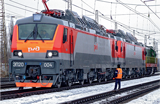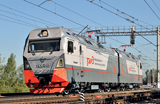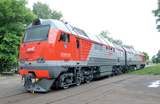Service functions
-
Download center
-
Add to My Report
-
My Report (0)
-
Print this Page
-
Download in PDF
-
Share
-
Feedback
-
Interactive analysis
-
Browsing history
-
Offline version
-
Company in soc.networks
-
Compared to 2011
-
Popular pages
-
Company on the map
-
Compact view
| Enter e-mail recipient * | Your e-mail * | Comment : | |
| * required fields | |||
Production of Locomotives with Asynchronous Traction Drive
In 2012, with the support of JSC “Russian Railways”, joint projects between Russian manufacturers and their foreign partners were successfully implemented in the development and production of innovative rolling stock — Sinara Group with Siemens AG and CJSC Transmashholding with Alstom. Both foreign companies are world leaders in their fields of activity.
Moreover, in 2012:
- the technical specification for the 2TE116UD diesel locomotive with a General Electric engine and for the 2TE25AM diesel locomotive with a MTU engine were approved.
- acceptance tests of the TEM 14 double diesel locomotive and EP20 electric locomotive with asynchronous traction motors were carried out.
- qualification tests of 2ES10 electric locomotive were carried out.
- technical requirements for a locomotive with a gas-fueled reciprocating engine and GT1I natural-gas-powered locomotive were developed.
- the technical specification for the development of a
4-axle piggybackcontainer platform was approved. - the acceptance tests of a covered goods wagon with sliding walls and an axle load of 25 ton-force were carried out.
- the draft design of the ES2G electric train was completed (LLC Ural Locomotives).
- Advantages of the asynchronous traction drive:
- Increased power with the same dimensions as a DC motor
- Longer life cycle
- Improved reliability
- Reduced life cycle cost
- Possibility of electric regenerative/dynamic braking to stop
- Increased tonnage rating
| EP20 Olymp Passenger Electric Train | 2ES10 Granit Freight Locomotive | 2ES5 Freight AC Electric Locomotive | 2TE25A Vityaz Main Line Diesel Freight Locomotive | TEM9H Diesel Shunting Locomotive |

| 2013 | 2014 | 2015 |
|---|---|---|
| 30 | 25 | 24 |
The two-system EP20 locomotive with asynchronous traction motors was developed by the engineering center Rail Transport Technologies, a joint venture of CJSC Transmashholding and Alstom Transport. The locomotives are produced by Novocherkassk Electric Locomotive Plant (part of the CJSC Transmashholding Group).
This is a pilot project aimed to develop a single platform of 5th generation Russian electric trains. Certification testing of the new EP20 passenger electric train has been successfully completed (see details in the Section “Development of the Express and High-Speed Rail Network”).
EP20 is designed for express passenger traffic (up to 200 km/h) and has the following characteristics: it does not have any equivalents in the “1520 area” and is very competitive with foreign trains; its life cycle costs are 15% lower than existing models.

| 2013 | 2014 | 2015 |
|---|---|---|
| 40 | 50 | 55 |
The 2ES10 Granit locomotive with asynchronous traction motors was developed by LLC Ural Locomotives in collaboration with Siemens AG. About 60% of the engineering solutions used in its design have been deployed in the Russian mechanical engineering industry for the first time. The performance of the 2ES10 locomotive is over three times higher compared to the currently used 1.5 VL11 locomotives. In addition, it is much more energy efficient: the specific energy consumption is 30% lower and the specific recovery is over 2.2 times higher.
The new generation of electric freight locomotives will be one of the main factors behind the increasing efficiency of the transportation process: they provide the possibility to manage heavy freight train traffic on complex routes without the reformation of trains or the use of pushing engines. In 2012, the Granit hauled a train weighing 9,000 tons from the West Siberian Railway to the Ust-Luga port through the Ural Mountains over a distance of 4,000 kilometers.

In 2012 two pilot models of the 2ES5 two-unit freight AC electric locomotive were produced and commercial tests were carried out.
The microprocessor control system and the automated radio control system of the new electric locomotive enables simultaneous operation of two, three and four sections of the locomotive in the head, middle and tail of the train. This allows the hauling of several connected trains with distributed traction.
The locomotive can be operated by one locomotive driver.
In addition, the electric locomotive is equipped with a radio control system to be used for the pushing engine.

| 2013 | 2014 | 2015 |
|---|---|---|
| 11 | 30 | 56 |
In order to eliminate the technological gap in the new generation of production of locomotive diesel engines, JSC “Russian Railways” made the decision to involve leading foreign companies in their development.
In 2012 CJSC Transmashholding produced and certified pilot models of the 2TE25A Vityaz main line two-unit diesel freight locomotive motorized with diesel engines of Tognum (MTU trade mark), Series 4000, with power of 2,700 kW (in the section).
The diesel locomotives are being tested in the locomotive depot Bryansk-Lgovsky.


An innovative project to develop the first Russian shunting locomotive with a hybrid drive was implemented by the engineering company STM Center of Innovation Development of OJSC Simara — Transport Machines, a mechanical-engineering holding company. Its development was approved by the NGO Foundation for Development of the Center of Research and Commercializing of New Technologies (Skolkovo innovation center). JSC “Russian Railways” is the main scientific and technical partner in the development of the new locomotive.
The prototype of the TEM9H shuttling locomotive, produced by the Lyudinovo Diesel Locomotive Plant, is equipped with an intelligent hybrid power unit with a capacity of 882 kW, which combines ecofriendly internal combustion diesel engine (630 kW) and lithium-ion batteries and super capacitors (252 kW).
The diesel locomotive can be used for shunting operations, including indoors, as its noise levels have been reduced. The new locomotive complies with high environment and energy efficiency foreign standards: compared to the previous model (TEM9) diesel consumption has been reduced by 30% and exhaust emissions into the environment have been reduced by up to 55%. In line with current trends in transport engineering, the locomotive was designed with a modular structure: the frame contains a diesel generator, cabin, sanitary and other modules, with each control unit is fitted with a selfdiagnostic system that helps to quickly identify and fix the problem. In 2012 the locomotive was tested and the results were used to improve the construction of its components and assemblies.
 Address of the President
Address of the President
 175th Anniversary of Russian Railways
175th Anniversary of Russian Railways
 Analysis
Analysis
 Save Key Indicators to XLS
Save Key Indicators to XLS
 Transport Development Strategy
Transport Development Strategy
 Investment Activity
Investment Activity
 Download Chapter Financial and Economic Performance
Download Chapter Financial and Economic Performance
 Rating
Rating
 Loan Portfolio
Loan Portfolio
 Management System
Management System
 Governing Structure Of JSC Russian Railways
Governing Structure Of JSC Russian Railways
 Personnel management
Personnel management
 Housing policy
Housing policy